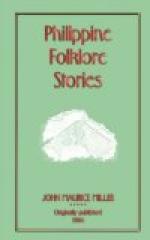Many years have passed since then. New races have come to the Islands, and new manners and customs have been introduced. The Pasig still flows on to the sea, but its banks are harnessed by bridges. Lofty dwellings and stores take the place of the little huts, and a great city marks the site of the little village.
Where once was the beautiful field is now a busy part of the great city. It is called Quiapo, after the lilies. Many of the older people remember the prophecy and wonder if the lilies will ever return.
The land is now a peaceful and contented one. Comfort and happiness may be found among its inhabitants. Perhaps the fair, strange women from the great land over the sea are the lilies. Who can tell?
Glossary
balete tree = a type of tree, Ficus indica, often believed to be the home of evil and vengeful spirits. camisas = shirts. chinela = slipper. cocheros = drivers of horse-drawn carriages. Datto = chief. Guardia Civil = Spanish police. ladrones = thieves. lubi lana = coconut oil. Moro = Muslim’s from the southern islands of the Philippines. Negritos = Negroid people indigenous in some parts of the Philippines. nipa = palm leaf of which the roofs of cheap houses are made. sacayan = small outrigger boat. tuba = alcoholic drink made from the sap of the coconut tree. tungud = the red bark of a mangrove tree.



